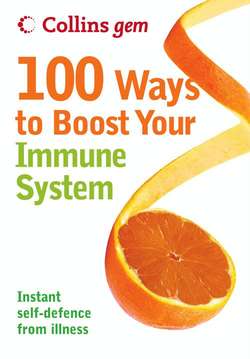Читать книгу 100 Ways to Boost Your Immune System - Theresa Cheung, Theresa Cheung - Страница 31
8 Sugar shut down
ОглавлениеThe next time you’re tempted to grab a bar of chocolate, down a sugary drink or tuck into a sugary cereal, give your immune system a break and have a piece of fruit or a bowl of oatmeal instead.
The impact of refined white sugar on your immune system can be enormous. Eating or drinking 100 grams (8 tablespoons) of sugar – the equivalent of about two cans of a full-sugar fizzy drink – can reduce the ability of your white blood cells to kill germs by 40 per cent. The immune-suppressing effect of sugar starts less than 30 minutes after ingestion and may last for up to 5 hours. On top of all this, a diet high in sugar increases your risk of blood-sugar imbalances that can trigger mood swings, weight gain, fatigue, headaches, hormonal imbalances and a host of other unpleasant symptoms.
If you do only one thing to boost your immune system, eliminating sugar will do the trick. Sugar gives you no nutrients, just calories. You will see noticeable results in your energy levels, weight distribution, immunity and ability to think clearly when you break the cravings and stop eating refined sugar.
Cutting down on your sugar intake may seem daunting at first, but it is easier than you think if you follow these tips to total sugar shut-down:
Sweet substitutes: Try fruits and unsweetened fruit juices more often in meals and snacks to cut down on sugar. Fruits have natural sugars, but they also give you important vitamins and minerals. Plan to have fresh fruit in season for desserts. Use dried fruits to sweeten cereals and baked goods. Slice a banana or fresh peach instead of using jam on a peanut butter sandwich. Make your own fizzy drinks with unsweetened fruit juice and sparkling water.
Pass on the sugar: Take the sugar bowl off the table and, if you add sugar to your tea, gradually cut down until you need none at all. Persevere with this because once your taste buds get used to tea and other hot drinks without sugar, you’ll never want to switch back. And while you are cutting down, reduce the amount of sugar you use in baking as well.
Don’t ban sugar altogether: Some sugar, judiciously added to wholesome foods, may make them more appetising; a sprinkling of brown sugar on oatmeal or grapefruit, or a teaspoon of maple syrup on winter squash enhances the taste of these healthy options. It is better to avoid sugar substitutes, as some studies suggest that they can also have an adverse effect on your health.
Cereal killer: Some breakfast cereals have four or more teaspoons of sugar added to each serving! When you buy unsweetened cereals you may be saving money and you can add your own sweetener at home, if you choose. Sprinkle fresh, canned or dried fruit on your cereal to sweeten.
Read labels: When food shopping, read ingredient labels to find the amount and types of sugars that have been added to the food. There are many kinds of sugar that are used to make a food sweet and crisp. Look for words that end in ‘ose’ or ‘ol’, such as dextrose, fructose, maltose, sucrose, glucose, lactose, mannitol and sorbitol. These are all forms of sugar. Syrups such as corn sweetener, sorghum syrup and high-fructose syrups are sweeteners that are often added to drinks. Brown sugar, molasses and honey may be ‘natural’, but they all give you the same calories as refined table sugar. Ingredients are listed in order by weight, from most to least, so when a type of sugar or syrup is the first ingredient, you will know there is more sugar in that food than any other ingredient. Some foods may contain many kinds of sugar. When they are added up, the total may be more than any other ingredient in that food.
Switch from white bread, pasta and rice to wholegrain alternatives: Wholegrains are packed with nutrients and fibre that can keep your blood-sugar levels and your appetite balanced for hours after eating, unlike sugar, which gives you a quick high followed by a long low.
